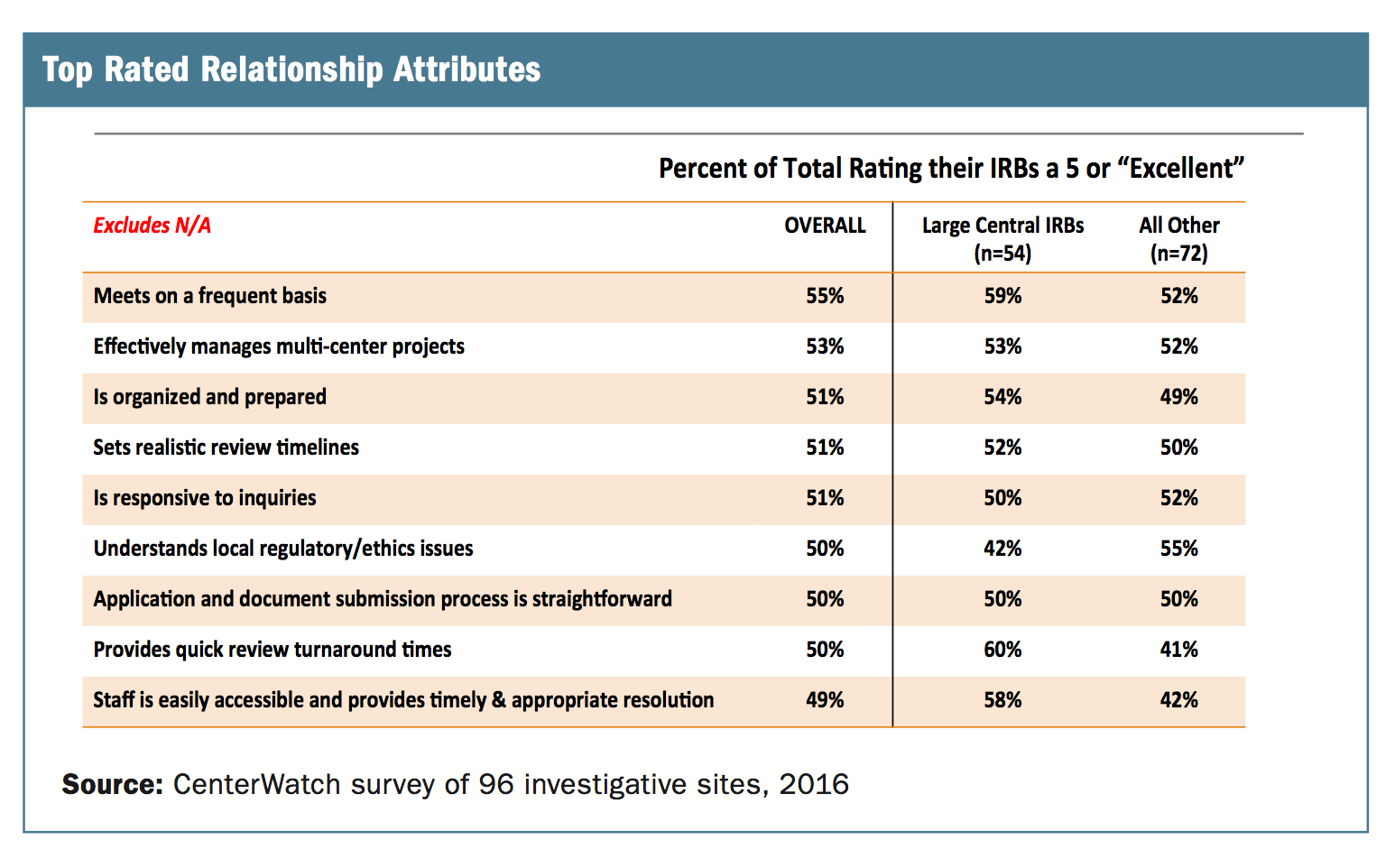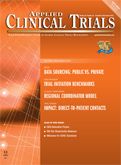IRB-Investigative Site Relationship Makeover
Applied Clinical Trials
New study finds that the long-strained relationship between sites and institutional review boards may finally be improving.
Investigative sites have always had a strained relationship with institutional review boards (IRBs). Perennial complaints from research center staff about excessive oversight, inefficient and bureaucratic processes and poor communication, however, have received little attention historically. Market trends and their impact, captured in a recent study, indicate that this strained relationship is undergoing a makeover.
Ken Getz

To differentiate their capabilities, IRBs are proactively implementing more efficient processes and technologies to streamline ethical review and oversight and nurture stronger relationships with their investigative sites. And the clinical research enterprise as a whole is shifting to a centralized ethical review model to drive higher levels of ethical oversight quality and efficiency (e.g., the NIH has mandated a single IRB review for multisite studies it funds in the U.S. and the federal government has proposed changes to increase reliance on central IRBs). Many sponsor companies and CROs are beginning to require central IRB review as a condition for investigative sites to participate in multicenter studies.
These changes, particularly those implemented by major IRBs during the past four to six years are already having an impact. A 2016 CenterWatch survey finds that the quality of the relationship between IRBs and investigative sites has improved in recent years. Overall, approximately three-out-of-four sites give IRBs “Good” or “Excellent” ratings across a majority of the relationship attributes measured. Attributes that received the highest ratings included general project management; being organized; and setting realistic review timelines. Areas that received lower ratings included poor communication, the need for more clarity and guidance for completing forms and simplifying the use of electronic document management.
As the IRB landscape has consolidated during the past several years, the largest IRBs, including WIRB-Copernicus Group (WCG), Chesapeake IRB, Schulman IRB, BRANY IRB and Quorum Review IRB, outperformed their smaller counterparts in a majority of relationship categories measured. Smaller IRBs, which included both central and local IRBs, earned higher marks for understanding local regulatory and ethics issues.
An unusual assessment
CenterWatch conducted an assessment online between June and September 2016 among a global community of sites. The survey marks a first-ever effort to measure the quality of IRB-site relationships. In the past, sites were reluctant to respond. This new study received completed surveys from 96 international respondents with 64% based in North America, 17% in Europe, 14% in Asia Pacific, 4% from South America and 2% from Africa.
Twenty-eight relationship quality attributes were measured across four categories: General project management; personnel and work style; document submission; and document review. The most frequently used IRB services included protocol-continuing review, informed consent review, changes in research/protocol amendments and initial protocol review.
Calling out communication
The top rated relationship attributes were most commonly observed in the general project management category (see chart below). More than half of respondents gave IRBs “Excellent” ratings for meeting on a frequent basis; effectively managing multi-center projects; being responsive to inquiries; setting realistic review timelines; and being organized and prepared. Only 2% of respondents, on average, gave IRBs a “Poor” rating in the project management category. For many project management attributes, large central IRBs received higher scores than did their smaller counterparts.

Communication attributes generally received the lowest relative ratings. Investigative site staff reported that they want real-time access to IRB personnel when questions arise during electronic submissions or during a monitoring visit. But respondents gave IRBs lower ratings for having staff easily accessible; for resolving questions in a timely manner; and for generally providing a single contact person. Sites also indicated that IRBs could do a better job of more clearly communicating delays, with nearly one-third indicating that IRB performance in this area was below expectations.
Compared to large central IRBs, the smaller review boards received poorer ratings from investigative sites for clearly communicating delays, for staff accessibility and for generally providing a single point of contact.
Investigative sites also reported communication problems when sponsors and CROs submit documents to a central IRB on their behalf. CROs typically have committees or processes that examine the site documents to identify and correct any potential problems or inconsistencies before the site-specific documents are sent to the central IRB for review. Yet investigative sites are not always sent updates or informed about delays in this submission process.
Improving document submission
Investigative sites reported that electronic document submission systems have improved since they were first introduced and that technology has helped simplify IRB submissions. However, sites identified the document review processes as a top area for improvement. Almost a quarter (24%) of respondents gave IRBs neutral or low marks for ease-of-use of electronic document management systems. Other areas for improvement include providing adequate guidelines for completing forms; using client portals effectively; and providing effective document review tracking processes.
Investigative sites indicated that they want to see more consistency between applications used by different IRBs. Sites also noted that IRB applications frequently require redundant information in multiple sections of document submissions.
Almost half (48%) of investigative sites perceive IRB oversight of document submissions to be moderately to very excessive. Only 39% gave IRBs an “Excellent” rating for proposing substantive document revisions. Sites report that some IRBs have protracted discussions on the order of words in a paragraph; correct grammar in study documents or site-designed advertisements; or focus on minor details that hold little to no bearing on study volunteer safety.
Less than half of sites give IRBs “Excellent” ratings for proposed document revisions that are generally clear (43%); for an effective auditing process (44%); for generally consistent review outcomes (48%); and for delivering consistent review turnaround times across similar projects (49%).
Size matters
The largest central IRBs receive the highest ratings from sites. These IRBs are investing resources to improve operating processes and to create and adopt technology solutions. Larger IRBs tend to have boards that meet more frequently. And higher review volume gives larger central IRBs more experience and opportunity to scale processes and systems.
Among general project management attributes, small percentage point differences in ratings was observed between the top five IRBs and all other IRBs. The largest IRBs generally outperformed smaller IRBs with regards to personnel and workstyle attributes including having easily accessible staff and clearly communicating delays. Large IRBs also received higher relative ratings for managing documentation-particularly electronic document management-and in providing effective document review processes.
Smaller IRBs received higher marks than did their larger peers in understanding local regulatory/ethics issues and in understanding local cultural needs.
IRB landscape change
There are numerous signs that the IRB landscape will continue to build efficiency and centralized management capabilities. The growing acceptance by regulators and industry for a central ethical review model is facilitating a shift away from local institution-based boards. As few universities or hospitals have the capacity to review protocols and track adverse events at multiple sites, these institutions will need to expand their use of commercial, central IRBs that have the experience and scale to oversee a large volume of active trials.
Some industry experts believe that going forward, the amount of research under local IRB oversight will continue to consolidate. The experts argue that local IRBs will largely support investigator-initiated trials in their institutions, some investigator-initiated single-study NIH grants and other federal grants. As a result, academic medical centers and hospitals will need to rely increasingly on external IRB service providers while still being aware of the research at their local institutions.
The future outlook in the CenterWatch survey was mixed. Half of respondents believe that the proposed changes to the Common Rule that ould mandate a single IRB review for multisite studies in the U.S. could help streamline IRB operations and provide more consistent oversight and documentation requirements. A similar percentage believes that a single-set of guidelines for human subject protection could help reduce workloads and improve efficiencies.
The new CenterWatch survey offers a good baseline from which to identify improvement areas supporting IRB-site relationships. Regular assessments will characterize progress made in strengthening this mission-critical relationship.
Kenneth A. Getz, MBA, is the Director of Sponsored Research at the Tufts CSDD and Chairman of CISCRP, both in Boston, MA, e-mail: kenneth.getz@tufts.edu

Improving Relationships and Diversifying the Site Selection Process
April 17th 2025In this episode of the Applied Clinical Trials Podcast, Liz Beatty, co-founder and chief strategy officer, Inato, discusses a number of topics around site engagement including community-based sites, the role of technology in improving site/sponsor relationships, how increased operational costs are impacting the industry, and more.
SCOPE Summit 2025: Enhancing the Patient Experience Through Site Centricity
February 12th 2025In an interview with ACT senior editor Andy Studna at SCOPE Summit, Ashley Davidson, vice president, product lead - sponsor tech strategy, Advarra, highlights the need for more site-centric approaches in study startup.